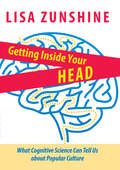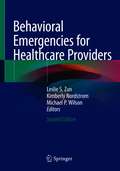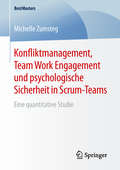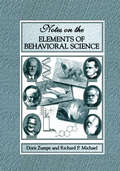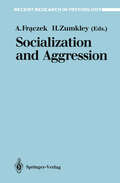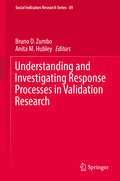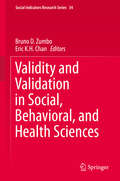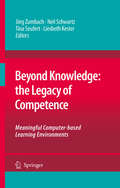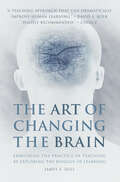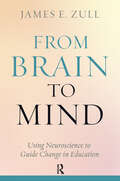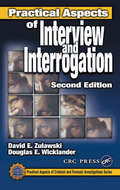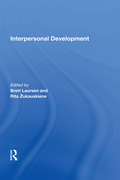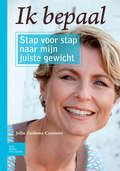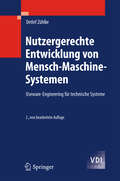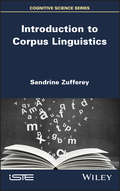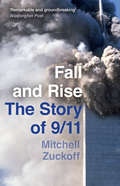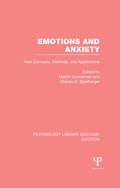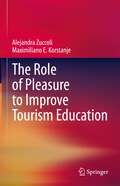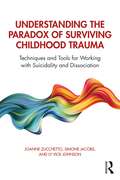- Table View
- List View
Getting Inside Your Head: What Cognitive Science Can Tell Us about Popular Culture
by Lisa ZunshineWe live in other people's heads: avidly, reluctantly, consciously, unaware, mistakenly, and inescapably. Our social life is a constant negotiation among what we think we know about each other's thoughts and feelings, what we want each other to think we know, and what we would dearly love to know but don't.Cognitive scientists have a special term for the evolved cognitive adaptation that makes us attribute mental states to other people through observation of their body language; they call it theory of mind. Getting Inside Your Head uses research in theory of mind to look at movies, musicals, novels, classic Chinese opera, stand-up comedy, mock-documentaries, photography, and reality television. It follows Pride and Prejudice’s Mr. Darcy as he tries to conceal his anger, Tyler Durden as he lectures a stranger at gunpoint in Fight Club, and Ingrid Bergman as she fakes interest in horse races in Notorious.This engaging book exemplifies the new interdisciplinary field of cognitive cultural studies, demonstrating that collaboration between cognitive science and cultural studies is both exciting and productive.
Behavioral Emergencies for Healthcare Providers
by Leslie S. Zun Kimberly Nordstrom Michael P. WilsonThis fully updated second edition focuses on mental illness, both globally and in terms of specific mental-health-related visits encountered in emergency department settings, and provides practical input from physicians experienced with adult emergency psychiatric patients. It covers the pre-hospital setting and advising on evidence-based practice; from collaborating with psychiatric colleagues to establishing a psychiatric service in your emergency department. Potential dilemmas when treating pregnant, geriatric or homeless patients with mental illness are discussed in detail, along with the more challenging behavioral diagnoses such as substance abuse, factitious and personality disorders, delirium, dementia, and PTSD. The new edition of Behavioral Emergencies for Healthcare Providers will be an invaluable resource for psychiatrists, psychologists, psychiatric and emergency department nurses, trainee and experienced emergency physicians, and other mental health workers.
Konfliktmanagement, Team Work Engagement und psychologische Sicherheit in Scrum-Teams: Eine quantitative Studie (BestMasters)
by Michelle ZumstegMichelle Zumsteg untersucht unterschiedliche Konfliktstile in Scrum-Teams und deren Effekt auf das arbeitsbezogene Wohlbefinden in den Teams. Die Autorin stellt sich ebenfalls der Frage, ob der Zusammenhang zwischen den Konfliktstilen und dem Team Work Engagement durch die erlebte psychologische Sicherheit in der Teamarbeit vermittelt wird. Im Rahmen einer Online-Befragung von 68 in der IT und Softwareentwicklung tätigen Scrum-Teams aus 20 Unternehmen konnte ein starker positiver Effekt des kooperativen Konfliktstils auf das Team Work Engagement ermittelt werden. Ebenfalls konnte ein negativer Zusammenhang zwischen dem kompetitiven und dem vermeidenden Konfliktstil mit Team Work Engagement festgestellt werden.
Notes on the Elements of Behavioral Science
by Doris Zumpe Richard P. MichaelThese notes are intended to help undergraduates who need to understand something of behavior both for its intrinsic interest and for their future careers in medicine, biology, psychology, anthropology, veterinary medicine, and nursing. In Emory University's Biology Department, a single-semester course called Evolutionary Perspectives on Behavior is given to undergraduates. It amounts to four, not eight months of study, so a great deal of compression is essential. There are several excellent textbooks available that deal with behavioral science from different perspectives, but we have found them too compendious for use in a short course when students are so heavily burdened; it is unsatisfactory to direct them to a chapter here and there in several different books or to this or that review article and original paper. In this volume, we have tried effectively and inexpensively to put in one place what we know is needed. The topics we have selected deal with their subjects in a simple, straightforward way without being too superficial. We could not cover everything and the gaps are not entirely idiosyncratic but reflect what students are given very well in other courses. Thus, there is no mention of the physiology of the axon and synapse; learning, memory, cognition, and basic genetics are hardly touched upon because students know about these matters from elsewhere.
Socialization and Aggression (Recent Research in Psychology)
by Horst Zumkley Adam FŗczekAuthors from Europe and the USA give a summary in this book of the current psychological knowledge about the socialization determinants of human aggressive behavior development and outline theoretical perspectives as wellas directions of future research. Thus, the volume includes theoretical and conceptual chapters concerning socialization and sources of aggression (Part I), chapters presenting a summary of empirical researchon early developmental determinants of aggressive and antisocial behavior patterns (Part II), chapters on the effects of social norms and education onaggression in children and youth (Part III), and finally contributions analyzing relationship between aggression as a psychological phenomenon and socio-cultural phenomena and processes (Part IV). The contributing authors have outstanding research experience and significant publications on socialization and aggression development. Their studies are embedded in various philosophical traditions and specific socio-cultural experiences; the book therefore provides a wide range of approaches and syntheses of current research.
Understanding and Investigating Response Processes in Validation Research (Social Indicators Research Series #69)
by Bruno D. Zumbo Anita M. HubleyThis volume addresses an urgent need across multiple disciplines to broaden our understanding and use of response processes evidence of test validity. It builds on the themes and findings of the volume Validity and Validation in Social, Behavioral, and Health Sciences (Zumbo & Chan, 2014), with a focus on measurement validity evidence based on response processes. Approximately 1000 studies are published each year examining the validity of inferences made from tests and measures in the social, behavioural, and health sciences. The widely accepted Standards for Educational and Psychological Testing (1999, 2014) present five sources of evidence for validity: content-related, response processes, internal structure, relationships with other variables, and consequences of testing. Many studies focus on internal structure and relationships with other variables sources of evidence, which have a long history in validation research, known methodologies, and numerous exemplars in the literature. Far less is understood by test users and researchers conducting validation work about how to think about and apply new and emerging sources of validity evidence. This groundbreaking volume is the first to present conceptual models of response processes, methodological issues that arise in gathering response processes evidence, as well as applications and exemplars for providing response processes evidence in validation work.
Validity and Validation in Social, Behavioral, and Health Sciences (Social Indicators Research Series #54)
by Bruno D. Zumbo Eric K.H. ChanThis book combines an overview of validity theory, trends in validation practices and a review of standards and guidelines in several international jurisdictions with research synthesis of the validity evidence in different research areas. An overview of theory is both useful and timely, in view of the increased use of tests and measures for decision-making, ranking and policy purposes in large-scale testing, assessment and social indicators and quality of life research. Research synthesis is needed to help us assemble, critically appraise and integrate the overwhelming volume of research on validity in different contexts. Rather than examining whether any given measure is “valid”, the focus is on a critical appraisal of the kinds of validity evidence reported in the published research literature. The five sources of validity evidence discussed are: content-related, response processes, internal structure, associations with other variables and consequences. The 15 syntheses included here, represent a broad sampling of psychosocial, health, medical and educational research settings, giving us an extensive evidential basis to build upon earlier studies. The book concludes with a meta-synthesis of the 15 syntheses and a discussion of the current thinking of validation practices by leading experts in the field.
Beyond Knowledge: Meaningful Computer-based Learning Environments
by Jörg Zumbach Liesbeth Kester Neil Schwartz Tina SeufertThe edited and peer reviewed volume presents selected papers of the conference “Beyond knowlegde: the legacy of competence” organized by EARLI SIG Learning and Instruction with Computers in cooperation with SIG Instructional Design. It reflects the current state-of-the-art work of scholars worldwide within the area of learning and instruction with computers. Mainly, areas of computer-based learning environments supporting competence-focused knowledge acquisition but also foundational scientific work are addressed. More specific, contents cover cognitive processes in hypermedia and multimedia learning, social issues in computer-supported collaborative learning, motivation and emotion in Blended Learning and e-Learning.
The Art of Changing the Brain: Enriching the Practice of Teaching by Exploring the Biology of Learning
by James E. ZullNeuroscience tells us that the products of the mind--thought, emotions, artistic creation--are the result of the interactions of the biological brain with our senses and the physical world: in short, that thinking and learning are the products of a biological process.This realization, that learning actually alters the brain by changing the number and strength of synapses, offers a powerful foundation for rethinking teaching practice and one's philosophy of teaching.James Zull invites teachers in higher education or any other setting to accompany him in his exploration of what scientists can tell us about the brain and to discover how this knowledge can influence the practice of teaching. He describes the brain in clear non-technical language and an engaging conversational tone, highlighting its functions and parts and how they interact, and always relating them to the real world of the classroom and his own evolution as a teacher. "The Art of Changing the Brain" is grounded in the practicalities and challenges of creating effective opportunities for deep and lasting learning, and of dealing with students as unique learners.
The Art of Changing the Brain: Enriching the Practice of Teaching by Exploring the Biology of Learning
by James E. ZullNeuroscience tells us that the products of the mind--thought, emotions, artistic creation--are the result of the interactions of the biological brain with our senses and the physical world: in short, that thinking and learning are the products of a biological process.This realization, that learning actually alters the brain by changing the number and strength of synapses, offers a powerful foundation for rethinking teaching practice and one's philosophy of teaching.James Zull invites teachers in higher education or any other setting to accompany him in his exploration of what scientists can tell us about the brain and to discover how this knowledge can influence the practice of teaching. He describes the brain in clear non-technical language and an engaging conversational tone, highlighting its functions and parts and how they interact, and always relating them to the real world of the classroom and his own evolution as a teacher. "The Art of Changing the Brain" is grounded in the practicalities and challenges of creating effective opportunities for deep and lasting learning, and of dealing with students as unique learners.
From Brain to Mind: Using Neuroscience to Guide Change in Education
by James E. ZullFinalist for Foreword Magazine's 2011 Book of the YearWith his knack for making science intelligible for the layman, and his ability to illuminate scientific concepts through analogy and reference to personal experience, James Zull offers the reader an engrossing and coherent introduction to what neuroscience can tell us about cognitive development through experience, and its implications for education.Stating that educational change is underway and that the time is ripe to recognize that “the primary objective of education is to understand human learning” and that “all other objectives depend on achieving this understanding”, James Zull challenges the reader to focus on this purpose, first for her or himself, and then for those for whose learning they are responsible. The book is addressed to all learners and educators – to the reader as self-educator embarked on the journey of lifelong learning, to the reader as parent, and to readers who are educators in schools or university settings, as well as mentors and trainers in the workplace.In this work, James Zull presents cognitive development as a journey taken by the brain, from an organ of organized cells, blood vessels, and chemicals at birth, through its shaping by experience and environment into potentially to the most powerful and exquisite force in the universe, the human mind.Zull begins his journey with sensory-motor learning, and how that leads to discovery, and discovery to emotion. He then describes how deeper learning develops, how symbolic systems such as language and numbers emerge as tools for thought, how memory builds a knowledge base, and how memory is then used to create ideas and solve problems. Along the way he prompts us to think of new ways to shape educational experiences from early in life through adulthood, informed by the insight that metacognition lies at the root of all learning.At a time when we can expect to change jobs and careers frequently during our lifetime, when technology is changing society at break-neck speed, and we have instant access to almost infinite information and opinion, he argues that self-knowledge, awareness of how and why we think as we do, and the ability to adapt and learn, are critical to our survival as individuals; and that the transformation of education, in the light of all this and what neuroscience can tell us, is a key element in future development of healthy and productive societies.
From Brain to Mind: Using Neuroscience to Guide Change in Education
by James E. ZullFinalist for Foreword Magazine's 2011 Book of the YearWith his knack for making science intelligible for the layman, and his ability to illuminate scientific concepts through analogy and reference to personal experience, James Zull offers the reader an engrossing and coherent introduction to what neuroscience can tell us about cognitive development through experience, and its implications for education.Stating that educational change is underway and that the time is ripe to recognize that “the primary objective of education is to understand human learning” and that “all other objectives depend on achieving this understanding”, James Zull challenges the reader to focus on this purpose, first for her or himself, and then for those for whose learning they are responsible. The book is addressed to all learners and educators – to the reader as self-educator embarked on the journey of lifelong learning, to the reader as parent, and to readers who are educators in schools or university settings, as well as mentors and trainers in the workplace.In this work, James Zull presents cognitive development as a journey taken by the brain, from an organ of organized cells, blood vessels, and chemicals at birth, through its shaping by experience and environment into potentially to the most powerful and exquisite force in the universe, the human mind.Zull begins his journey with sensory-motor learning, and how that leads to discovery, and discovery to emotion. He then describes how deeper learning develops, how symbolic systems such as language and numbers emerge as tools for thought, how memory builds a knowledge base, and how memory is then used to create ideas and solve problems. Along the way he prompts us to think of new ways to shape educational experiences from early in life through adulthood, informed by the insight that metacognition lies at the root of all learning.At a time when we can expect to change jobs and careers frequently during our lifetime, when technology is changing society at break-neck speed, and we have instant access to almost infinite information and opinion, he argues that self-knowledge, awareness of how and why we think as we do, and the ability to adapt and learn, are critical to our survival as individuals; and that the transformation of education, in the light of all this and what neuroscience can tell us, is a key element in future development of healthy and productive societies.
Practical Aspects of Interview and Interrogation
by David E. Zulawski Douglas E. Wicklander Shane G. Sturman L. Wayne HooverWhat makes a person confess to a crime he did not commit? Was he coerced? Is he trying to protect someone else? Interrogation has come under attack as opponents focus on false confessions. However, most cases are still resolved by confession, not forensic evidence. Among the new topics covered in the Second Edition of this bestselling book, Practic
Interpersonal Development
by Rita ZukauskieneThis volume brings together for the first time the papers which have shaped and defined the field of interpersonal development. It celebrates the maturation of the subject by bringing together the best work by scholars who have been instrumental in furthering the field. The twenty-seven essays describe developmental changes in interactions within specific close relationships, covering parent-child relationships, friendships and peer relationships, romantic and spousal relationships, and sibling relationships. They also detail characteristics of specific relationships and interconnections among these key features, as well as tying close relationships to individual outcomes. The essays are accompanied by an introduction which offers a brief history of the field, a review of relationship definitions and a detailed preview of the articles.
Interpersonal Development
by Rita ZukauskieneThis volume brings together for the first time the papers which have shaped and defined the field of interpersonal development. It celebrates the maturation of the subject by bringing together the best work by scholars who have been instrumental in furthering the field. The twenty-seven essays describe developmental changes in interactions within specific close relationships, covering parent-child relationships, friendships and peer relationships, romantic and spousal relationships, and sibling relationships. They also detail characteristics of specific relationships and interconnections among these key features, as well as tying close relationships to individual outcomes. The essays are accompanied by an introduction which offers a brief history of the field, a review of relationship definitions and a detailed preview of the articles.
Ik bepaal: Stap voor stap naar mijn juiste gewicht
by Jellie Zuidema-CazemierWil je meer dan 5 kilo afvallen en zoek je naar een manier om je gewicht blijvend omlaag te brengen? Dan geef je jezelf met dit boek de beste kans van slagen! De meeste afslankboeken bepalen voor jou wat de beste manier is om af te vallen. Natuurlijk hebben de schrijvers van die boeken veel kennis en ervaring in huis. Daarom lukt het ook wel zon dieet een periode vol te houden. Toch val je vaak na een tijdje weer terug in je eigen, oude gewoonten. En stijgt daarbij je gewicht helaas weer. `Maar dit is toch ook een afslankboek, dus wat is dan het verschil?' Het verschil met andere dieetboeken is dat dit boek ervan uit gaat dat lijnen de beste kans van slagen heeft als jijzelf bepaalt wat je verandert en wanneer je dit doet. En dat je dit in kleine stappen doet om blijvend succes te garanderen. Het boek bevat vele mogelijke factoren die een rol spelen bij overgewicht. De opbouw van het boek is zodanig dat jijzelf steeds bepaalt welk onderdeel voor jou van toepassing is, óf je hieraan gaat werken en wanneer je dat doet. Het zit barstensvol duidelijke wetenschappelijke informatie, praktische tips en ervaringen van de schrijfster en lijners. Dit boek helpt jou - Je kennis te vergroten over alles wat invloed heeft op je gewicht - Uit de vele mogelijke oorzaken van overgewicht, die oorzaken te vinden die voor jou van toepassing zijn - Realistische en haalbare doelen te stellen, waardoor je jojo-en voorkomt - Uit te vinden hoe je anders wil eten en hoe je dingen anders wil doen om blijvend af te vallen - Te bepalen of het nu wel de beste tijd is om bepaalde gewoonten te veranderen - Nieuwe gewoonten vol te houden, zodat je afvalt en op gewicht blijft Met dit boek werk je stap voor stap toe naar een blijvend gezond gewicht.
Nutzergerechte Entwicklung von Mensch-Maschine-Systemen: Useware-Engineering für technische Systeme (VDI-Buch)
by Detlef ZühlkeDas Buch gibt Entwicklern einen Leitfaden zur nutzergerechten Gestaltung von Mensch-Maschine-Systemen an die Hand. Dabei werden die besonderen Gestaltungsprobleme von Useware-Systemen für internationale Märkte ebenso behandelt wie die Auswahl von Entwicklungstools, Normen und Richtlinien sowie grundlegende Gestaltungsregeln. Wichtige Neuerungen, etwa die modellbasierte Entwicklung von Benutzungsschnittstellen oder zukünftige Interaktionsformen, werden in der Neuauflage anhand von Gestaltungsbeispielen vorgestellt.
Useware-Engineering für technische Systeme (VDI-Buch)
by Detlef ZühlkeMit dem Begriff Useware ist eine Fokussierung der Technikgestaltung auf menschliche Fähigkeiten und Bedürfnisse an der Mensch-Maschine-Schnittstelle verbunden. Das Buch hilft Entwicklern in der Industrie und Forschung mit praktisch orientierten Beispielen für Gestaltungslösungen. Eine kurze Erläuterung der menschlichen Fähigkeiten erhöht das Verständnis für die Vorgehensweise bei der Gestaltung komplexer Useware-Systeme, die detailliert dargestellt wird.
Introduction to Corpus Linguistics
by Sandrine ZuffereyOver the past decades, the use of quantitative methods has become almost generalized in all domains of linguistics. However, using these methods requires a thorough understanding of the principles underlying them. Introduction to quantitative methods in linguistics aims at providing students with an up-to-date and accessible guide to both corpus linguistics and experimental linguistics. The objectives are to help students developing critical thinking about the way these methods are used in the literature and helping them to devise their own research projects using quantitative data analysis.
Introduction to Corpus Linguistics
by Sandrine ZuffereyOver the past decades, the use of quantitative methods has become almost generalized in all domains of linguistics. However, using these methods requires a thorough understanding of the principles underlying them. Introduction to quantitative methods in linguistics aims at providing students with an up-to-date and accessible guide to both corpus linguistics and experimental linguistics. The objectives are to help students developing critical thinking about the way these methods are used in the literature and helping them to devise their own research projects using quantitative data analysis.
Fall and Rise: The Story Of 9/11
by Mitchell ZuckoffTHE NEW YORK TIMES BESTSELLER ‘The farewell calls from the planes… the mounting terror of air traffic control… the mothers who knew they were witnessing their loved ones perish… From an author who’s spent 5 years reconstructing its horror, never has the story been told with such devastating, human force’ Daily Mail
Emotions and Anxiety: New Concepts, Methods, and Applications (Psychology Library Editions: Emotion)
by Marvin Zuckerman Charles D. SpielbergerFirst published in 1976, this volume was completely new with original contributions and traces the advances in theory and research on anxiety and emotion of the previous decade. The authors examine the origins of fear, anxiety, and other emotions and consider self-report and psychophysiological approaches to the measurement of anxiety. Also considered are the effects of anxiety on the behaviour of normal and abnormal subjects, and the volume concludes with behavioural approaches to assessment and treatment of anxiety in clinical settings.
Emotions and Anxiety: New Concepts, Methods, and Applications (Psychology Library Editions: Emotion)
by Marvin Zuckerman Charles D. SpielbergerFirst published in 1976, this volume was completely new with original contributions and traces the advances in theory and research on anxiety and emotion of the previous decade. The authors examine the origins of fear, anxiety, and other emotions and consider self-report and psychophysiological approaches to the measurement of anxiety. Also considered are the effects of anxiety on the behaviour of normal and abnormal subjects, and the volume concludes with behavioural approaches to assessment and treatment of anxiety in clinical settings.
The Role of Pleasure to Improve Tourism Education
by Alejandra Zuccoli Maximiliano E. KorstanjeThis book discusses how pleasure, as an emotional motivation, can play a leading role in improving the learning of new cognitive skills and abilities. Set in a research center orientated to innovate educative techniques for optimizing the learning process, this case study is focusing on the power of pleasure (joy) as a strategy to better the standard education systems in Argentina and beyond.This editorial project is based on an efficient experiment known as “PANCOE” where pre-graduate students of tourism bachelor at the University of Palermo, Argentina, were subject to different pleasurable experiences mainly marked by eating, tasting dishes and non-alcohol drinks while cooking and kneading bread pieces. PANCOE aims to integrate students' senses with their emotions, academic performance, and digital platforms. PANCOE devotes efforts to transforming negative feelings like fear into positive ones like joy. As an outcome, students who had taken part in PANCOE not only obtained higher degrees but also completed their studies with a bachelor's degree. Therefore, PANCOE situates as a promising and exciting tourism education method to better the academic performance of low-grade students in tourism and to bring creativity to the tourism classroom for all students.
Understanding the Paradox of Surviving Childhood Trauma: Techniques and Tools for Working with Suicidality and Dissociation
by Joanne Zucchetto Simone Jacobs Ly Vick JohnsonUnderstanding the Paradox of Surviving Childhood Trauma offers clinicians a new framework for understanding the symptoms and coping mechanisms displayed by survivors of childhood abuse. This approach considers how characteristics such as suicidality, self-harm, persistent depression, and anxiety can have roots in behaviors and beliefs that helped patients survive their trauma. This book provides practitioners with case examples, practical tips, and techniques for applying this mindset directly to their most complex cases. By depathologizing patients’ experiences and behaviors, and moving beyond simply managing them, therapists can reduce their clients’ shame and work collaboratively to understand the underlying message that these behaviors conceal.
